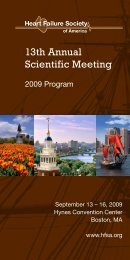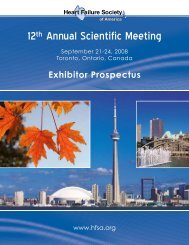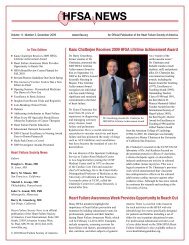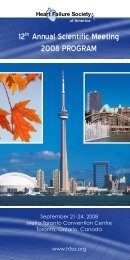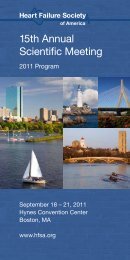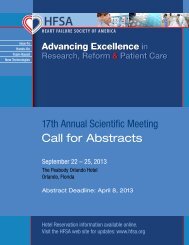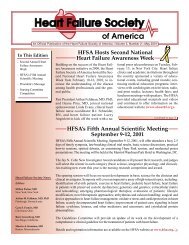Volume 3, Number 1 - Heart Failure Society of America
Volume 3, Number 1 - Heart Failure Society of America
Volume 3, Number 1 - Heart Failure Society of America
You also want an ePaper? Increase the reach of your titles
YUMPU automatically turns print PDFs into web optimized ePapers that Google loves.
<strong>Heart</strong> <strong>Failure</strong> <strong>Society</strong> News February 2001<br />
4th Annual Scientific Meeting Coverage<br />
Debates Invite Audience Participation in Controversies<br />
The four debate sessions <strong>of</strong> the annual<br />
scientific meeting, held at two sessions,<br />
provided excellent opportunities for<br />
stimulating exchanges <strong>of</strong> ideas on controversial<br />
areas. Audience participation<br />
via voting at the conclusion <strong>of</strong> each debate<br />
provided an immediate gauge <strong>of</strong> the<br />
effectiveness <strong>of</strong> the presentations. The<br />
first session was co-moderated by<br />
Michael Fowler, Stanford, California,<br />
and Kanu Chatterjee, San Francisco,<br />
California; the second session’s co-moderators<br />
were Lynne Warner Stevenson,<br />
Boston, Massachusetts, and Inderjit<br />
Anand, Minneapolis, Minnesota. Topics<br />
included the use <strong>of</strong> inotropes in patients<br />
with advanced heart failure, the expanded<br />
use <strong>of</strong> LVADs, the use <strong>of</strong> beta<br />
blockers in patients with advanced heart<br />
failure, and the role <strong>of</strong> apoptosis.<br />
Inotropes are Beneficial in Chronic<br />
<strong>Heart</strong> <strong>Failure</strong><br />
Evan Loh<br />
Recognizing the<br />
absence <strong>of</strong> a definitive<br />
guideline<br />
or good data<br />
on the use <strong>of</strong><br />
inotropes in<br />
class IV patients,<br />
Evan Loh<br />
argued that the<br />
use <strong>of</strong> inotropic<br />
agents is an effective bridge therapy for<br />
severely decompensated patients. He<br />
distinguished between progressively<br />
decompensated patients versus patients<br />
with ultra-decompensated symptoms, including<br />
end-organ damage, the need for<br />
balloon pumps, and perhaps ventricular<br />
assist. It is the latter group that can benefit<br />
from inotropic therapy to prolong life<br />
until transplantation can be performed.<br />
In addition to inadequate data are difficulties<br />
interpreting data, demographic<br />
uncertainties, and heterogeneity <strong>of</strong> clinical<br />
presentation on admission. Given the<br />
heterogeneity <strong>of</strong> symptoms at presentation,<br />
he stated that the development <strong>of</strong><br />
selection criteria is essential. Placing<br />
clinical trial data in perspective is a key<br />
element <strong>of</strong> selection criteria. He pointed<br />
out that the decade <strong>of</strong> the clinical trial is<br />
important, because our understanding has<br />
evolved. Additionally, we have concomitant<br />
therapy with ACE inhibitors as well<br />
as beta blockers, other endpoints such as<br />
quality <strong>of</strong> life, and better monitoring devices.<br />
He urged caution in interpreting<br />
clinical trial data, asking “Does intention<br />
to treat represent real world care?” “You<br />
can’t take clinical trial data in and <strong>of</strong> itself<br />
and apply it to every patient. Every<br />
patient is different,” he said. He cited<br />
more recent 1998 and 1999 data from<br />
small trials that suggest that intermittent<br />
intravenous dobutamine therapy, carefully<br />
monitored, may be beneficial in severely<br />
decompensated individuals.<br />
“Quality <strong>of</strong> life is important,” he said,<br />
“and our patients want to feel better.” He<br />
raised the issue <strong>of</strong> optimum dosing and<br />
recommended lower doses. He said, “We<br />
have gone from the use <strong>of</strong> inotropes to<br />
beta blockers. The pendulum is swinging<br />
back, and I wonder if our ability to<br />
use beta blockade in patients with heart<br />
failure may allow us to move ahead in<br />
the future and use inotropic therapy as a<br />
component <strong>of</strong> managing patients with advanced<br />
decompensated heart failure.”<br />
Stephen Gottleib disagreed. “The use <strong>of</strong><br />
inotropes in class IV patients,” he said,<br />
“has been shown to be consistently deleterious,<br />
contributing to the progression<br />
<strong>of</strong> heart failure, arrhythmias, and sudden<br />
death.” He charged that the positive trials<br />
cited by Dr. Loh were “small, uncontrolled,<br />
unblinded, and did not reflect<br />
acute effects and short term.” He argued<br />
that inotropes should only be used under<br />
investigational protocols and even then<br />
their use is questionable.<br />
6<br />
“There is no doubt that the use <strong>of</strong> positive<br />
inotropes increases mortality,” he<br />
said, noting that the patients who did the<br />
worst were class IV patients. He disputed<br />
the relevance <strong>of</strong> beta-blocker tolerability,<br />
reviewing the results <strong>of</strong> the<br />
COPERNICUS trial showing a 35% rate<br />
<strong>of</strong> increased survival in patients receiving<br />
these agents. He recommended the<br />
use <strong>of</strong> beta blockers to address the quality-<strong>of</strong>-life<br />
issues and was strong in his opposition<br />
to the combined use <strong>of</strong> inotropes<br />
and beta blockers.<br />
The audience sided with Dr. Gottleib. Before<br />
the start <strong>of</strong> the debate, 20% <strong>of</strong> the<br />
audience approved <strong>of</strong> the affirmative position.<br />
At the conclusion <strong>of</strong> the debate,<br />
30% approved <strong>of</strong> the affirmative position.<br />
The Time Has Come for Long-Term<br />
LVAD Treatment <strong>of</strong> <strong>Heart</strong> <strong>Failure</strong><br />
(Beyond Bridge to Transplant)<br />
Leslie Miller reminded the audience that<br />
there are 4.8 million patients with heart<br />
failure, over 1 million <strong>of</strong> whom are class<br />
III or class IV, and that there are more<br />
than 250,000 deaths annually. Clinical<br />
trials have shown that class IV patients<br />
have a 35% mortality rate; population<br />
studies suggest higher rates <strong>of</strong> 40% to<br />
50%. Given these statistics, he asserted,<br />
the increased use <strong>of</strong> left-ventricular assist<br />
devices (LVAD) is warranted.<br />
The complications that can accompany<br />
the devices include bleeding, infection,<br />
stroke, and emboli. The benefits, however,<br />
are impressive: increased exercise<br />
capacity; improved quality <strong>of</strong> life; improved<br />
LVED; improved histology, including<br />
less apoptosis and hypertrophy;<br />
decreased neurohormonal levels, including<br />
TNF and cytokines; cellular functional<br />
recovery increases; and increased<br />
gene expression. He concluded, “The data<br />
are overwhelming, as are the benefits <strong>of</strong><br />
effectiveness, safety, durability, portability,<br />
total implantability, and simplicity <strong>of</strong><br />
design.” “The future is bright,” he said,<br />
with three new devices in clinical trials<br />
and five more expected in 2001.<br />
Gary Francis opposed more widespread<br />
use <strong>of</strong> LVADs, pointing to the paucity<br />
<strong>of</strong> data and the absence <strong>of</strong> a protocol for<br />
weaning patients from the devices, as<br />
well as increased risk <strong>of</strong> myocardial fi-<br />
(continued on page 8)




